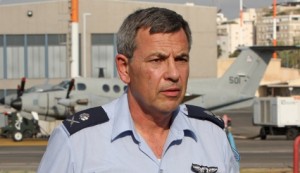Special to WorldTribune.com
HERZLIYA, Israel — Israel’s military has been exploring the prospect
of developing projects in the upper tier of the atmosphere.
Officials said the Israel Air Force has drafted plans to develop
aircraft that could operate in what they termed the stratosphere. They said
this would enable unmanned platforms to conduct reconnaissance and signals
intelligence missions over an enemy country at an altitude of more than
100,000 feet.

“The aircraft can remain there with heavy payloads, including electronic intelligence,” Air Force commander Maj. Gen. Ido Nehushtan said.
In a Jan. 29 address to the Fisher Brothers Institute for Space and Strategic Studies, Nehushtan outlined Air Force research and development priorities over the next decade. The commander said the Air Force’s use of the stratosphere would also allow for the airborne launch of micro-satellites.
“We want to be attentive to future changes,” Nehushtan said.
Officials said the air force was overseeing a program by the state-owned Israel Aerospace Industries and Rafael Advanced Defense Systems for an airborne satellite launch. They said the launch, in which a micro-satellite
would be shot from an F-15 fighter-jet through an air-to-air missile, could
take place by 2013 to demonstrate the feasibility of replacing standard
space-launch vehicles.
“Israel now operates UAVs on a scale that is unprecedented,” Nehushtan
said. “Twenty-five percent of all flight hours stem from UAVs. Many of the
things done here on the battlefield are not things that we thought they can
do. But they are flexible.”
Another proposal was for the development of a blimp that could reach the
stratosphere. The balloon, designed to exceed fighter-jet or anti-aircraft
missile range, would loiter over an enemy country for months and relay data
on missile launches or nuclear weapons efforts. The United States has
already been developing several models of such platforms in projects by
the National Aeronautics Space Agency, or NASA.
“To say that this will happen quickly, it certainly won’t,” Nehushtan
said. “Things in space don’t happen quickly. There is a very complex
budgetary issue that is taking place.”
Nehushtan said the stratosphere project would be part of the service’s
long-term vision, called Air Force 2030. He said the vision called for eight
areas of development, including information security, networking, autonomous
systems, environmental impact and technology education.
The commander said Air Force 2030 would depend on government funding and
the availability of technical manpower. Nehushtan said Israeli defense
exports, which reached No. 4 in the world in 2011, would be crucial in
helping finance the military’s vision.
“Our advantage is not only in technology,” Nehushtan said. “Many others
have technology. It is in the ability to use it properly.”
The general said Israel must invest greater resources in military
manpower and technology amid the revolts throughout the Middle East. He said
the revolts in such countries as Egypt, Libya and Syria could result in the
strengthening of insurgency groups, particularly the Iranian-sponsored
Hizbullah.
“Because regimes are weakening there is a greater possibility that
high-quality weapons might reach Hizbullah,” Nehushtan said. “Israel cannot
afford to sit back and do nothing. Hamas and other terror organizations of
the Gaza Strip have been taking advantage of Egypt. There are more and more
terror cells in the Sinai and the Egyptian government has to do something
about it.”

You must be logged in to post a comment Login